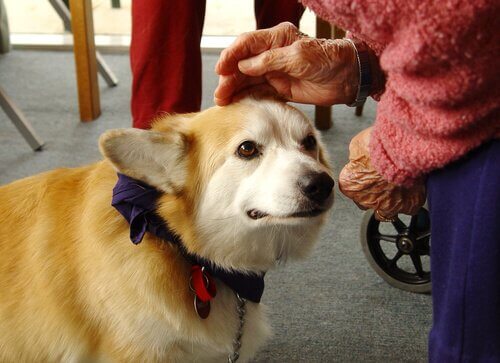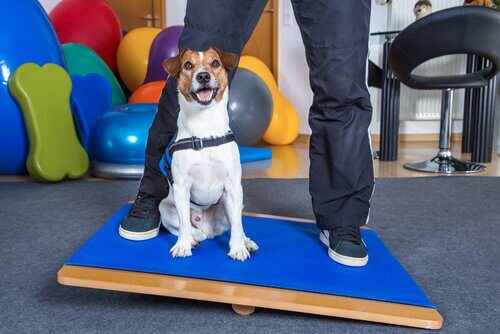The Benefits of Using Dogs in Animal-Assisted Therapy

Over the years, dogs have had many different roles in helping people, such as rescue dogs, police dogs, guide dogs for the blind, and many others. Today, you’ll learn about another very dignified, useful job our furry friends have. It’s all to do with using dogs in animal-assisted therapy.
Don’t confuse the use of dogs in animal-assisted therapy with assistance dogs. Assistance dogs are animals that live with people in need, for example as guide dogs for the blind. However, the dogs that are used in animal-assisted therapies have a different role. Would you like to know what this is?
First, let’s see what role they carry out. Then, we’ll look at the benefits.
The role of dogs in animal-assisted therapy

To start off with, you should know that animals that participate in assisted therapies usually live with one of the therapists, or even in the center they work in. They just carry out their job at certain hours, that is, when they have an appointment with the people who need the therapy.
Dogs aren’t the only animals used in assisted therapies. There are also certain occasions when dolphins, horses and even fish have been used.
Dogs are most commonly used because of the simplicity in dealing with them, and due to their sixth sense which helps them to understand us. Human relations are complex, and sometimes it can be hard to understand how each person feels. This, however, doesn’t happen with canines, since they transmit a sense of peace and tranquility. This is a great help in assisted therapies.
What are dogs used for?
Dogs have the role of improving cognitive, functional, emotional, physical, and social function in people. That’s why they’re used as “instruments” in assisted therapies. They can create a peaceful, relaxing environment that helps the patient to improve in all these areas.
What are the benefits of using dogs in animal-assisted therapy?
The benefits of using dogs in animal-assisted therapy fall into roughly 4 groups: psychological, psychomotor, sensory, and educative skills. Let’s look at each of these 4 groups and learn how dogs can help in each one.
Psychological benefits
- Improves the mood. It’s said that having someone joyful around you will also fill you with joy. Can you think of anyone happier than a dog? A playful friend who looks for you to play with him and who does his best to attract your attention will make you feel special, and therefore lift your mood.
- Helps to improve attention span. This has certainly been the case above all in kids with ADHD. Having someone you love draw close to you attracts your attention and makes you stay on the lookout for him.
- Reduces anxiety and stress.
- Favors social and physical contact. Many people find it hard to relate to others, but this would be much easier with a dog. Canines can make human social relations a little easier.
- Favors mental stimulation. Thinking about how to attract the dog’s attention, how to play with it etc, will help to maintain an active mind.
Psychomotor benefits
- Improves coordination.
- Improves muscular strength.
- Helps with fine motor skills. This happens by means of soft gestures such as patting, putting on a leash or giving it food.
Sensory benefits
- Helps proprioception. This is the sense that tells you about the position of your muscles. It also has to do with the vision and balance systems and other forms of body movements.
- Improves the vestibular system (your body’s balance system, found in the inner ear).
- Helps to improve the senses and creates auditory, tactile and visual stimulants.
Educational benefits of using dogs in animal-assisted therapy

- Promotes and improves social skills, promoting empathy, generosity and other similar qualities.
- Helps to take responsibilities seriously and to think about cooperation and teamwork.
- Reduces bad behavior.
- Promotes learning through playing.
As you can see, using dogs in assisted therapy has many benefits in every sense of the word. We hope to keep discovering many more uses for our canine friends, so that they can help more and more people in society.
Over the years, dogs have had many different roles in helping people, such as rescue dogs, police dogs, guide dogs for the blind, and many others. Today, you’ll learn about another very dignified, useful job our furry friends have. It’s all to do with using dogs in animal-assisted therapy.
Don’t confuse the use of dogs in animal-assisted therapy with assistance dogs. Assistance dogs are animals that live with people in need, for example as guide dogs for the blind. However, the dogs that are used in animal-assisted therapies have a different role. Would you like to know what this is?
First, let’s see what role they carry out. Then, we’ll look at the benefits.
The role of dogs in animal-assisted therapy

To start off with, you should know that animals that participate in assisted therapies usually live with one of the therapists, or even in the center they work in. They just carry out their job at certain hours, that is, when they have an appointment with the people who need the therapy.
Dogs aren’t the only animals used in assisted therapies. There are also certain occasions when dolphins, horses and even fish have been used.
Dogs are most commonly used because of the simplicity in dealing with them, and due to their sixth sense which helps them to understand us. Human relations are complex, and sometimes it can be hard to understand how each person feels. This, however, doesn’t happen with canines, since they transmit a sense of peace and tranquility. This is a great help in assisted therapies.
What are dogs used for?
Dogs have the role of improving cognitive, functional, emotional, physical, and social function in people. That’s why they’re used as “instruments” in assisted therapies. They can create a peaceful, relaxing environment that helps the patient to improve in all these areas.
What are the benefits of using dogs in animal-assisted therapy?
The benefits of using dogs in animal-assisted therapy fall into roughly 4 groups: psychological, psychomotor, sensory, and educative skills. Let’s look at each of these 4 groups and learn how dogs can help in each one.
Psychological benefits
- Improves the mood. It’s said that having someone joyful around you will also fill you with joy. Can you think of anyone happier than a dog? A playful friend who looks for you to play with him and who does his best to attract your attention will make you feel special, and therefore lift your mood.
- Helps to improve attention span. This has certainly been the case above all in kids with ADHD. Having someone you love draw close to you attracts your attention and makes you stay on the lookout for him.
- Reduces anxiety and stress.
- Favors social and physical contact. Many people find it hard to relate to others, but this would be much easier with a dog. Canines can make human social relations a little easier.
- Favors mental stimulation. Thinking about how to attract the dog’s attention, how to play with it etc, will help to maintain an active mind.
Psychomotor benefits
- Improves coordination.
- Improves muscular strength.
- Helps with fine motor skills. This happens by means of soft gestures such as patting, putting on a leash or giving it food.
Sensory benefits
- Helps proprioception. This is the sense that tells you about the position of your muscles. It also has to do with the vision and balance systems and other forms of body movements.
- Improves the vestibular system (your body’s balance system, found in the inner ear).
- Helps to improve the senses and creates auditory, tactile and visual stimulants.
Educational benefits of using dogs in animal-assisted therapy

- Promotes and improves social skills, promoting empathy, generosity and other similar qualities.
- Helps to take responsibilities seriously and to think about cooperation and teamwork.
- Reduces bad behavior.
- Promotes learning through playing.
As you can see, using dogs in assisted therapy has many benefits in every sense of the word. We hope to keep discovering many more uses for our canine friends, so that they can help more and more people in society.
This text is provided for informational purposes only and does not replace consultation with a professional. If in doubt, consult your specialist.








